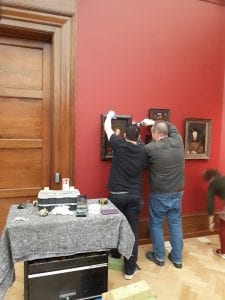Behind the scenes: Hanging a Bouts
Posted on by Lauren MacCarthy.
by Lisa Huang-Taylor, curatorial placement
I am currently on a placement with the curatorial department at Bristol Museum & Art Gallery and I went behind the scenes for the hanging of St Luke Drawing the Virgin and Child painted by the workshop of 15th century Flemish painter, Dieric Bouts.
 The painting was hung in the European Old Masters Gallery on Thursday 26 October, although preparation for its arrival and hanging began earlier in the week.
The painting was hung in the European Old Masters Gallery on Thursday 26 October, although preparation for its arrival and hanging began earlier in the week.
On the Monday, selected paintings in the gallery were removed and put into storage in order to vacate some wall space for the Bouts. The wall then needed to be prepared, with holes being filled up, the surface smoothed out and any imperfections in the paintwork touched up.
The painting arrived in Bristol on Wednesday from its home at The Bowes Museum in County Durham, but before it could be hung, it had to stay in its case overnight to allow it to acclimatise to its new environment.
The installation itself began at around 9am on Thursday morning. I arrived an hour after that time and was surprised to see how many of the paintings had already been hung.

Eleven paintings were being hung in total, ten from the gallery’s collection which were returning from storage. In the first hour of the day, six or seven paintings were hung. Given that these paintings date from the fifteenth century onwards the technicians must use their expertise and experience to carry out the process of hanging with extreme care, and must follow specific procedures meticulously.
Two technicians worked on physically hanging the paintings but several people were involved in the process, including the curator of the Old Master’s Gallery, the paintings conservator and two representatives from The Bowes Museum (and myself, trying to document the process without being a hindrance!).
The paintings waiting to be hung were lined up along the wall, resting on foam blocks. A process of measuring, positioning and drilling holes in the wall was carried out for each painting, one-by-one. I spied a spirit level amongst the collection of tools, however the final position of the paintings and their levelness is determined by sight. The frames themselves are not perfectly straight, so the curator must simply use keen eyes to gauge if they need tweaking.
All eleven paintings were hung in around two hours. One minor hiccup came in the form of a painting which needed to be taken down and rehung. When the paintings were taken off the gallery wall and moved into storage, the fixtures are rotated.

This is so that they don’t protrude from the frame and the painting can rest flat against the foam blocks. However, in the case of Lucas Cranach’s Portrait of Martin Luther, when it was rehung one of the fixtures had not been rotated back into its original position. This was swiftly rectified and they moved onwards to the next tasks.
Each step of the hang took a great attention to detail. The painting conservator carefully painted the hanging fixtures, camouflaging them against the deep red of the gallery walls.
When the wall labels were being put in place the curator surveyed each one. This was to ensure that they were perfectly positioned, not too close or not too far away from the paintings.
The final, yet very careful step in the process is the lighting. An electrician worked with the curator to ensure that the lighting for each painting was just right.
The individual qualities of each painting make its lighting requirements slightly different; some paintings are naturally darker, some have lighter frames, some are much smaller than others and for all of them it must be ensured that the light is at no more than 200 lux.

The electrician and curator worked through each painting, adjusting the light until it was perfect and this process was much slower and more painstaking than I had expected. It is the final stage in a long line of tasks to ensure that the works of art are displayed in a setting that does justice to them, and so it is an understandably meticulous task.
The Bouts proved the toughest lighting challenge. In terms of scale, it is much larger than the paintings surrounding it and the frame is by far the brightest and most vibrant gold in the whole of the Old Master’s Gallery.
It took a little longer, and more of the careful ‘up a bit, down a bit’ adjustments but the end result was worth it. By about 2pm the hang was complete and the Bouts was positioned proudly in its new temporary home.
See this gallery on our exhibitions online
Find out more about St Luke Drawing the Virgin and Child by the workshop of Dieric Bouts.
Supported by:

